The following is a timeline of the history of the city of Chicago, Illinois, United States.
Before the 19th century
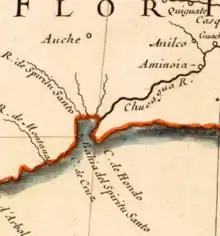
As interpreted from the 1670 translation of the de Soto narrative into French by Pierre Richelet, the Chucagua River, was believed to be the Mississippi. La Salle named Checagou, the transliterated from Spanish, as the gateway to the River of de Soto.
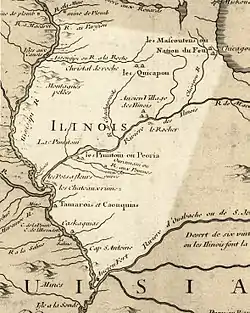
Site of Chicagou on the lake, in Guillaume de L'Isle's map (Paris, 1718)
- 1673: French-Canadian explorers Jacques Marquette and Louis Jolliet, on their way to Québec, pass through the area that will become Chicago.
- 1677: Father Claude Allouez arrived to try to convert the natives to Christianity
- 1682: French explorer René Robert Cavelier, Sieur de la Salle, passes through Chicago en route to the mouth of the Mississippi River.
- 1696: Jesuit missionary Francois Pinet founds the Mission of the Guardian Angel. It is abandoned four years later.
- 1705: Conflicts develop between French traders and the Fox tribe of Native Americans.
- 1719: The Comanche Indian Tribe settle in the Great Plains and in the Midwest of the United States.
- 1754: The Illinois Country becomes part of New France, days later The French and Indian War begins with the war against the British.
- 1763: The Illinois Country falls to British Troops after the defeat of New France.
- 1775: The Revolutionary War begins with America declaring independence from Britain.
- 1778: The Illinois Campaign is born under the command of George Rogers Clark to lead the fight against major British outposts scattered across the country.
- 1780s: Jean Baptiste Point du Sable establishes Chicago's first permanent settlement near the mouth of the Chicago River.
- 1795: Six square miles (16 km2) of land at the mouth of the Chicago River are reserved by the Treaty of Greenville for use by the United States.
- 1796: Kittahawa, du Sable's Potawatomi Indian wife, delivers Eulalia Point du Sable, Chicago's first recorded birth.
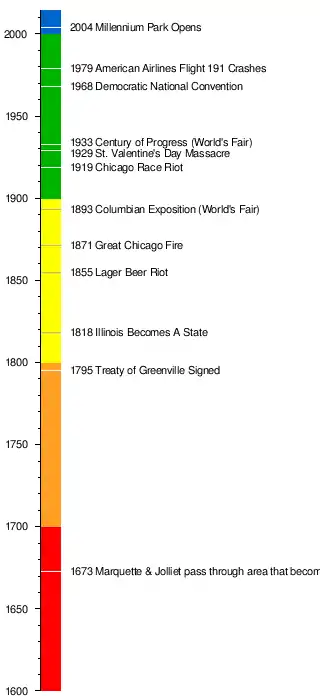 |
19th century
1800s–1840s
- 1803: The United States Army orders the construction of Fort Dearborn by Major John Whistler. It is built near the mouth of the Chicago River.
- 1812
- June 17, Jean La Lime is killed by John Kinzie, making him the first recorded murder victim in Chicago.
- August 15, the Battle of Fort Dearborn.
- 1816: The Treaty of St. Louis is signed in St. Louis, Missouri. Ft. Dearborn is rebuilt.
- 1818: December 3, Illinois joins the Union and becomes a state.
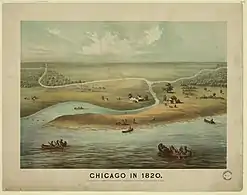
1820 Chicago
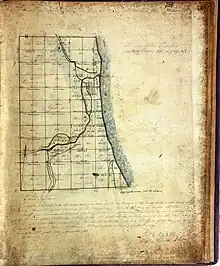
1821 Survey of Chicago
- 1830
- August 4, Chicago is surveyed and platted for the first time by James Thompson.
- Population: "Less than 100".[1]
- 1833
- 1833 Treaty of Chicago
- Chicago incorporated as a town.[1]
- 1835
- August 31, about 800 Potawatomi men gathered for a war dance in Chicago before being removed to west of the Mississippi River.[2]
- 1837
- Chicago incorporated as a city.[1]
- C.D. Peacock jewelers was founded. It is the oldest Chicago business still operating today.
- Chicago receives its first charter.[3]
- Rush Medical College is founded two days before the city was chartered. It is the first medical school in the state of Illinois which is still operating.
- The remaining 450 Potawatomi left Chicago.
- 1840
- July 10, Chicago's first legally executed criminal, John Stone was hanged for rape and murder.
- Population: 4,470.[4]
- 1844: Lake Park designated.[5]
- 1847: June 10, The first issue of the Chicago Tribune is published.
- 1848
- Chicago Board of Trade opens on April 3 by 82 local businessmen.
- Illinois and Michigan Canal opens and traffic begins moving faster.
- Galena and Chicago Union Railroad enters operation becoming the first railroad in Chicago
- 1849
- Wauconda is founded.
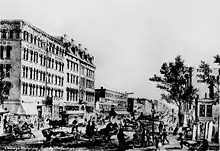
Merchants' Hotel on left, looking North from State and Washington Streets, before 1868
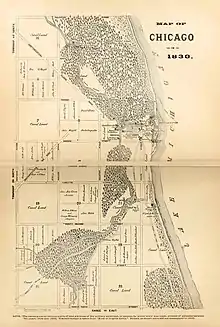
Chicago in 1830, as depicted in 1884
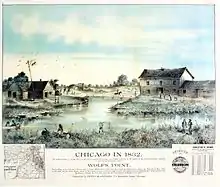
Chicago in 1832, as depicted in 1892
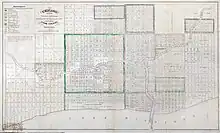
Chicago in 1836
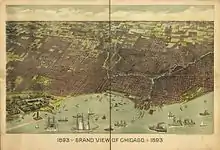
1893 Bird's eye view of Chicago

Fort Dearborn depicted as in 1831, sketched 1850s although the accuracy of the sketch was debated soon after it appeared.
1850s–1890s
- 1850: Population: 29,963.[4]
- 1851: Chicago's first institution of higher education, Northwestern University, is founded.
- 1852: Mercy Hospital becomes the first hospital in Illinois.
- 1853
- October: State Convention of the Colored Citizens held in city.[6]
- Union Park named.[5]
- 1854: A cholera epidemic took the lives of 5.5% of the population of Chicago.[7]
- 1855
- Chicago Theological Seminary founded.[1]
- April 21, Lager Beer riot.
- Population: 80,000.[5]
- 1856: Chicago Historical Society founded.
- 1857
- Iwan Ries & Co. Chicago's oldest family-owned business opens, still in operation today, the oldest family-owned tobacco shop.
- Mathias A. Klein & Sons (Klein Tools Inc.), still family owned and run today by fifth and sixth generation Klein's.
- Cook County Hospital opens.[1]
- Hyde Park House built.[5]
- 1859: McCormick Theological Seminary relocated.[1]
- 1860
- September 8, the Lady Elgin Disaster.
- Population: 112,172.[4]
- Daprato Statuary Company (Currently Daprato Rigali Studios) founded by the Daprato brothers, Italian immigrants from Barga.
- 1865
- 1866: School of the Art Institute of Chicago founded.
- 1867
- Construction began on the Water Tower designed by architect W. W. Boyington.
- Chicago Academy of Music founded.[5]
- 1868
- Rand McNally is formed as a railway guide company.
- Lincoln Park Zoo founded.[5]
- 1869
- Chicago Water Tower built.
- The first Illinois woman suffrage convention was held in Chicago
- The Chicago Club is established.
- Washington Square Park being developed.[5]
- 1870
- St. Ignatius College founded, later Loyola University
- Population: 298,977.[4]
- 1871: October 8 – 10, the Great Chicago Fire.[5][8]
- 1872
- Montgomery Ward in business.
- Establishment of the first Black fire company in the city.

The original library, inside the old water tower on the site that is now the Rookery Building.

This former water tower was the site of the original public library, exterior view
- 1873: Chicago Public Library established.[5]
- 1875: Holy Name Cathedral dedicated.[5]
- 1877: Railroad strike.[9]
.jpg.webp)
Art Institute of Chicago As seen from Michigan Ave
- 1878
- Art Institute of Chicago established.
- Conservator newspaper begins publication.[10][11]
- 1879: Art Institute of Chicago founded.[1]
- 1880
- Polish National Alliance headquartered in city.
- Population: 503,185. [12]
- 1881
- Unsightly beggar ordinance effected.[13]
- A smallpox epidemic killed around 2,500 people.[14]

Home Insurance Building
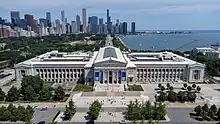
Field Museum in Chicago
- 1885: Home Insurance Building building was the first skyscraper that stood in Chicago from 1885 to 1931. Originally ten stories and 138 ft (42.1 m) tall, it was designed by William Le Baron Jenney in 1884[15][16] Two floors were added in 1891, bringing its now finished height to 180 feet (54.9 meters). It was the first tall building to be supported both inside and outside by a fireproof structural steel frame, though it also included reinforced concrete. A landmark lost to history and is considered the world's first skyscraper.

Chicago Water Tower and Chicago Avenue Pumping Station, circa 1886
- 1886
- May 4, the Haymarket riot.[17]
- Chicago Evening Post published (until 1932).[1]
- 1887: Newberry Library established.
- 1888: Dearborn Observatory rebuilt.
- 1889
- Hull House founded.[1][18]
- Auditorium Building completed.[1]
- Auditorium Theatre opened.
- 1890
- The University of Chicago is founded by John D. Rockefeller.
- Population: 1,099,850. [19]
- 1891
- Chicago Symphony Orchestra founded by Theodore Thomas.[1]
- Provident Hospital founded.[1]
- Serial killer H.H. Holmes murdered at least 5 people in Englewood, Chicago between 1891-1894.
- 1892
- June 6, The Chicago and South Side Rapid Transit Railroad, Chicago's first 'L' line, went into operation.
- Masonic Temple for two years, the tallest building in Chicago.
- Streetcar tunnels in Chicago (under the Chicago River) in use until 1906.[1]
- 1893
- May 1 – October 30, The World's Columbian Exposition (World's Fair); World's Parliament of Religions held.[20][1]
- October 28, Mayor Carter Harrison, Sr. was assassinated by Patrick Eugene Prendergast.[21]
- Sears, Roebuck and Company in business.
- First Ferris wheel built by George Washington Gale Ferris Jr.
- Art Institute of Chicago building opens.[1]
- Monadnock Building completed.[1]
- Universal Peace Congress held.[22]
- Chicago Civic Federation founded.[21]
- 1894
- May 11 – August 2, the Pullman Strike.[17][1]
- Ženské Listy women's magazine begins publication.[23][24]
- Field Museum of Natural History established.[1]
- 1895: Marquette Building completed.[1]
- 1896
- 1896 Democratic National Convention held; Bryan delivers Cross of Gold speech.[25]
- Campaign "to improve municipal service and politics" begun in 1896.[1]
- Abeny beauty shop[26] and Tonnesen Sisters photo studio[27] in business.
- 1897
- March 12, The Chicago Elevator Protective Association of Chicago was formed. Later, on July 15, 1901, to become the International Union of Elevator Constructors Local 2.
- The Union Loop Elevated is completed.
- National union of meat packers formed.[1]
- 1898: National peace jubilee was held.[1]
- 1899
- Cook County juvenile court established.[28]
- Municipal Art League established.[1]
- Carson, Pirie, Scott and Company Building constructed.

Chicago-Sanitary-and-Ship-Canal, during construction

Map of the business portion of Chicago
- 1900
- Chicago Sanitary and Ship Canal opens;[29] the Chicago River is completely reversed.
- Municipal Reference Library active (approximate date).[30]
- Labor strike of machinists.[9]
- Population: 1,698,575.[1]
20th century

Construction of the Chicago Drainage Canal, 1900s
1900s–1940s
- 1902: Meatpacking strike.[9]
- 1903
- December 30, Iroquois Theater Fire
- City Club of Chicago formed.
- 1905
- The Industrial Workers of the World was founded in June[31]
- Teamsters' strike.[1]
- Chicago Defender newspaper begins publication.[32]
- City Hall rebuilding completed.[1]
- Chicago Federal Building completed.[1]
- 1906
- Municipal court established.[28]
- The Chicago White Sox defeated the Chicago Cubs in the only all-Chicago World Series.
- Sinclair's fictional The Jungle published.[17]
- Chicago Tunnel Company operated a 2 ft. narrow-gauge railway freight tunnel network (until 1959).[1]
- 1907: Adolph Kroch opens a bookstore which will evolve into Kroch's and Brentano's
- 1908
- The Chicago Cubs win the World Series for the second year in a row
- Binga Bank in business.[33]
- 1909: Burnham's Plan of Chicago presented.[17]
- 1910: Population: 2,185,283.[1][34]
- July 1: Comiskey Park opened (originally called White Sox Park).
- December 22: Chicago Union Stock Yards fire (1910)
- 1911: Chicago and North Western Railway Terminal completed.[1]
- 1912:
- Harriet Monroe starts Poetry, which will soon make Chicago a magnet for modern poets.
- 1913
- Great Lakes Storm of 1913
- Wabash Avenue YMCA opens.[35]
- 1914: Alpha Suffrage Club active.[36]
- April 23: Wrigley Field opened (originally called Weeghman Park).

All Star Tournament, 18 Inch Balke Line, Chicago, May 7–14, 1906
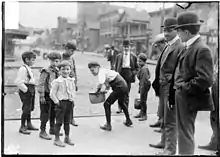
Jewish men and boys standing on a sidewalk in Chicago, 1903
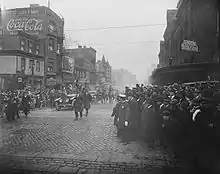
Theodore Roosevelt in Chicago, 1915
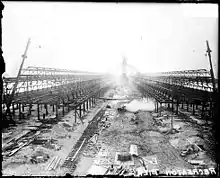
During construction, 1915 (Chicago Daily News)
- 1915
- July 24, the SS Eastland Disaster.
- Chicago Municipal Tuberculosis Sanitarium founded.[34]
- 1916
- 1917: The Chicago White Sox win the MLB World Series.
- 1918
- Micheaux Film and Book Company in business.[37]
- The Spanish flu killed over 8,500 people in Chicago between September and November 1918.
- 1919
- July 27, the Chicago race riot of 1919.
- Real estate broker Archibald Teller opened the first Fannie May candy store.
- 1920: Population: 2,701,705.[34]
- 1921
- Balaban and Katz Chicago Theatre built, (later the Chicago Theatre).
- Field Museum of Natural History relocates to Chicago Park District.[34]
- Street-widening and street-opening projects underway.[34]
- Medill School of Journalism opens.[34]
- 1922: Chicago Council on Global Affairs established.[38]
- 1924
- Murder trial and conviction of Leopold and Loeb.
- October 9: Soldier Field opened.
- 1925
- Goodman Theatre established.
- Chicago railway station opened.[34]
- The Tribune Tower was completed on Michigan Avenue. The building's large Gothic entrance contains pieces of stone from other famous buildings: Westminster Abbey, Cologne Cathedral, the Alamo, the Taj Mahal, the Great Pyramid, and the Arc de Triomphe.
- 1926
- Nederlander Theatre opened.
- Granada Theatre opened.
- 1927: Originally called the Chicago Municipal Airport, Chicago Midway International Airport opened. It was renamed in 1949 to honor the Battle of Midway in World War II.
- July 28: 27 people, mostly women and children, were killed in the Favorite Boat Disaster.
- 1929
- February 14, the St. Valentine's Day Massacre.[25][39]
- Oscar De Priest becomes U.S. representative for Illinois's 1st congressional district.[40][41]
- Civic Opera Building & Civic Opera House opened.
- 1930
- March 6: 50,000 gather for International Unemployment Day, capping 10 days of protest against Great Depression conditions.
- May 12, Adler Planetarium opened, through a gift from local merchant Max Adler. It was the first planetarium in the Western Hemisphere.[42]
- April 6, Twinkies are in Invented in Schiller Park.
- May 30, Shedd Aquarium opens.
- The Merchandise Mart was built for Marshall Field & Co. The $32 million, 4.2 million square foot (390,000 m2) building was the world's largest commercial building. It was sold it to Joseph P. Kennedy in 1945.
- Population: 3,376,438. [43]
- 1933
- Museum of Science and Industry (Chicago) opened.
- March 6: Mayor Anton Cermak was killed while riding in a car with President-elect Roosevelt. The assassin was thought to have been aiming for Roosevelt.
- 1933–34: Century of Progress World's Fair.
- 1934
- May 19: Chicago Union Stock Yards fire (1934)
- July 1: Brookfield Zoo opened.
- July 22: John Dillinger was shot by the FBI in the alley next to the Biograph Theater.[25]
- 1935
- January 19: Coopers Inc. sells the world's first briefs.
- Jay Berwanger of the University of Chicago is awarded the very first Heisman Trophy
- 1937: Labor strike of steelworkers.[9]
- 1938: Community Factbook begins publication.[44]
- 1940: Population: 3,396,808. [45]
- 1944: Premiere of Williams' play The Glass Menagerie.
- 1945: Ebony magazine begins publication.[46]
- 1946: Construction of Thatcher Homes begins.
- 1948: Chicago Daily Sun and Times newspaper begins publication.[10]
1950s–1990s
- 1950
- Chess Records in business.[47]
- Population: 3,620,962. This was the peak of Chicago's population, which has been declining ever since. [48]
- 1953: American Indian Center, the oldest urban Native American center in the United States, opened.
- 1954: Johnson Products Company in business.
- 1955: The first McDonald's franchise restaurant, owned by Ray Kroc, opened in the suburb of Des Plaines.
- 1958
- December 1, Our Lady of the Angels School Fire.
- The last streetcar ran in the city. At one time, Chicago had the largest streetcar system in the world.
- 1959: Second City comedy troupe active.
- 1960
- September 26: Nixon-Kennedy televised presidential debate held.[25]
- The first of the Playboy Clubs, featuring bunnies, opened in Chicago.
- Population: 3,550,404. [49]
- 1963 – Donald Rumsfeld became U.S. representative for Illinois's 13th congressional district.[50]
- 1965–66 – The Chicago Freedom Movement, centering on the topic of open housing, paves the way for the 1968 Fair Housing Act.
- 1966
- July 13–14: Chicago student nurse massacre
- 1967
- January 26 – 27, Major snowstorm deposits 23 inches of snow, closing the city for several days.
- August 1: maiden voyage of UAC TurboTrain.
- 1968:
- February 7: Mickelberry Sausage Company plant explosion kills nine and injured 70.
- August 26 – 29, 1968 Democratic National Convention and its accompanying anti-Vietnam War protests.
- 1969
- October: Weathermen's antiwar demonstration.[51]
- December 4: Black Panther Fred Hampton assassinated.
- The Chicago 8 trial opens.
- The 100-floor John Hancock Center was built.
- 1970
- Soul Train television program begins broadcasting.
- Casa Aztlán (organization) founded.[52]
- Population: 3,366,957. [53]
- 1971: Segundo Ruiz Belvis Cultural Center founded.[54]
- 1972: Vietnam Veterans Against the War headquartered in Chicago.
- 1973: Sears Tower, the tallest building in the world for the next 25 years, was completed.
- 1974: Steppenwolf Theatre Company founded.
- 1977: Chicago Marathon begins.[47]
- 1978: First BBS goes online on February 16.
- 1979
- Heavy snowstorm and city's slow response lead to upset of incumbent mayor.
- May 25, the American Airlines Flight 191 crashes.
- Chicago's first female mayor, Jane M. Byrne, takes office.
- Woodstock Institute headquartered in city.[55]
- 1980: Population: 3,005,072. [56]
- 1981: Hill Street Blues television show premieres on January 15.
- 1982
- September – October: Chicago Tylenol murders
- 1983
- Harold Washington became the first African American mayor.[57]
- Ordinance banning handguns takes effect.[39][58]
- 1984
- The Chicago Cubs reach the postseason for the first time since 1945
- The Nike shoe Air Jordan is made for superstar basketball player of the Chicago Bulls Michael Jordan.
- Heartland Institute headquartered in city.[59]
- 1986
- Oprah Winfrey's Harpo Productions, Inc. in business.
- The Chicago Bears win Super Bowl XX
- Presidential Towers complex completed
- 1988
- Lights are installed in Wrigley Field
- February 7, The NBA hosts its all-star game at the Chicago Stadium in Chicago.
- Christian Peacemaker Teams headquartered in city.[59]
- 1990: Population: 2,783,726.[4]
- 1991
- May 28, at the Consumer Electronics Show in Chicago, Sony proudly revealed that it was working with Nintendo to create a version of the Super NES with an in-built CD drive. The two Japanese companies had been working together in secret on the project, tentatively titled the Nintendo PlayStation, since 1989 and with the hype about CD-ROM reaching fever pitch, Sony’s announcement should have been a highlight of the trade show. Eventually leads to betrayal of the company Nintendo to Sony into Leading to the beginning of PlayStation console.[60]
- The Chicago Bulls won their first NBA championship.
- 1992: April 13, the Chicago Flood.
- 1995
- The Chicago Heat Wave of 1995.
- Your Radio Playhouse begins broadcasting.
- Kroch's and Brentano's, once the largest privately owned bookstore chain in the US, closes.
- 1996
- Chicago hosts the 1996 Democratic National Convention, sparking protests such as the one whereby Civil Rights Movement historian Randy Kryn and 10 others were arrested by the Federal Protective Service.[61]
- City website online (approximate date).[62][63]
- 1998: The Chicago Bulls won their sixth NBA championship in eight years.
21st century
2000s–Present
- 2000: Population: 2,895,671. [64]
- 2001:
- 2002: Lakeview Polar Bear Club founded (now known as the Chicago Polar Bear Club).
- 2003
- Meigs Field closed after having large X-shaped gouges dug into the runway surface by bulldozers in the middle of the night.
- Chicago Film Archives founded.
- February 17: 2003 E2 nightclub stampede
- June 29: 2003 Chicago balcony collapse
- 2004: Millennium Park opens.[65]
- 2005
- The Chicago White Sox win their first World Series in 88 years.
- Regional Chicago Metropolitan Agency for Planning established.[66]
- 2006
- May 1, the 2006 U.S. immigration reform protests draw over 400,000.
- Cloud Gate artwork installed in Millennium Park.
- 2008: November 4, US President-elect Barack Obama makes his victory speech in Grant Park.

In 2009, an Amtrak Lake Shore Limited train backing into Chicago Union Station

Chicago Theater in 2011
- 2010
- June 28: US supreme court case McDonald v. City of Chicago decided; overturns city handgun ban.[58]
- Chicago Blackhawks win the Stanley Cup.
- City of Chicago Data Portal launched.
- Population: 2,695,598. [67]
- 2011
- February 2: 900 cars abandoned on Lake Shore Drive due to Blizzard.
- March 30: Last of Cabrini Green towers torn down.
- Rahm Emanuel becomes mayor.
- Population: 8,707,120; metro 17,504,753.[68]
- 2012
- 38th G8 summit and 2012 Chicago Summit are to take place in Chicago.
- The first of an ongoing franchise of NBC Chicago-set dramas, Chicago Fire, makes its world premiere on WMAQ
- 2013
- Chicago Blackhawks win the Stanley Cup scoring 2 goals in 17 seconds to defeat the Boston Bruins
- Robin Kelly becomes U.S. representative for Illinois's 2nd congressional district.
- 2014:
- January: Chiberia
- August: Archer Daniels Midland completes its headquarters move from Decatur to the Loop.
- November 2: Wallenda performs high-wire stunt.[69]
- 2015
- 606 linear park opens.
- Chicago Blackhawks win the Stanley Cup yet again for the third time in six years, establishing a "puck dynasty" nationwide and arguably becoming the best team in the NHL.
- Video of the murder of Laquan McDonald is released by court order, and protests ensue.
- 2016:
- June 16: McDonald's announces it will move its headquarters from Oak Brook to the West Loop by 2018.
- ConAgra completes its headquarters move from Omaha to the Merchandise Mart.
- November 2: Cubs win the world series.

Navy Pier in 2017
- 2017
- January 21: Women's protest against U.S. president Trump.[70]
- City approves public high school "post-graduation plan" graduation requirement (to be effected 2020).[71]
- The unsolved mystery of Death of Kenneka Jenkins was killed at a hotel.
- 2018: Walgreens announces the move of its headquarters from Deerfield, including 2,000 jobs, to the Old Chicago Main Post Office.

14th Street Coach Yard and Willis Tower, October 2018
- 2019
- May 20: Lori Lightfoot becomes the first female African-American mayor of Chicago.
- 2020
- February 16: The NBA hosts its all-star game at the United Center in Chicago.
- March 16: First Chicago death due to the COVID-19 pandemic; Governor J. B. Pritzker and Mayor Lori Lightfoot issue a stay at home order. Over 7,700 people in Chicago died in the pandemic.
- May 28 – June 1: George Floyd protests in Chicago
- Population: 2,741,730. [72]
- 2022
- May – July: 2022-2023 abortion protests
- Venezuelan refugee crisis
- 2023
- May 15: Brandon Johnson becomes mayor.
See also
References
- 1 2 3 4 5 6 7 8 9 10 11 12 13 14 15 16 17 18 19 20 21 22 23 24 25 26 27 28 29 30 Britannica 1910.
- ↑ Reardon, Patrick (August 24, 2016). "Chicago's trail of tears: Potawatomi warriors' 1835 dance marked eviction". Retrieved November 10, 2023.
- ↑ Federal Writers’ Project (1939). "Chicago". Illinois: A Descriptive and Historical Guide. American Guide Series. Chicago: A.C. McClurg & Co.
- 1 2 3 4 5 Population of the 100 Largest Cities and Other Urban Places in the United States: 1790 to 1990, US Census Bureau, 1998
- 1 2 3 4 5 6 7 8 9 10 11 12 Britannica 1878.
- ↑ "Conventions Organized by Year". Colored Conventions. University of Delaware. Archived from the original on April 16, 2014. Retrieved April 30, 2014.
- ↑ "Chicago at a Glance (chronology)". Chicago Daily News Almanac and Year Book for 1916. 1915.
- ↑ Benjamin Vincent (1910), "Chicago", Haydn's Dictionary of Dates (25th ed.), London: Ward, Lock & Co.
- 1 2 3 4 Aaron Brenner; Benjamin Day; Immanuel Ness, eds. (2015) [2009]. "Timeline". Encyclopedia of Strikes in American History. Routledge. ISBN 978-1-317-45707-7.
- 1 2 "US Newspaper Directory". Chronicling America. Washington DC: Library of Congress. Retrieved February 21, 2014.
- ↑ "Timeline". The Black Press: Soldiers Without Swords. USA: Public Broadcasting Service. Retrieved January 30, 2015.
- ↑ "Chicago, Illinois Population History 1840 - 2021". Retrieved November 25, 2023.
- ↑ Susan M. Schweik (2010). The Ugly Laws: Disability in Public. New York University Press. ISBN 978-0-8147-8361-0.
- ↑ "Municipal Tuberculosis Sanitarium Complex" (PDF). Retrieved January 7, 2024.
- ↑ "United States and Canada, 1800–1900 A.D.: Key Events". Heilbrunn Timeline of Art History. New York: Metropolitan Museum of Art. Retrieved December 30, 2014.
- ↑ "A history of cities in 50 buildings", The Guardian, UK, 2015
- 1 2 3 4 Paul S. Boyer, ed. (2001). "Chicago". Oxford Companion to United States History. Oxford University Press. ISBN 978-0-19-508209-8.
- ↑ Thomas Dublin, Kathryn Kish Sklar (ed.), "Chronology", Women and Social Movements in the United States, Alexander Street Press (subscription required)
- ↑ "Chicago, Illinois Population History 1840 - 2021". Retrieved November 25, 2023.
- ↑ Melinda Corey and George Ochoa, ed. (1999). Fitzroy Dearborn Chronology of Ideas. Fitzroy Dearborn. ISBN 978-1-135-94710-1.
- 1 2 Catherine Cocks; et al. (2009). "Chronology". Historical Dictionary of the Progressive Era. Scarecrow Press. ISBN 978-0-8108-6293-7.
- ↑ Official report of the fifth Universal Peace Congress held at Chicago, United States of America, August 14 to 20, 1893, The American peace society, 1893
- ↑ Bibliography of Foreign Language Newspapers and Periodicals Published in Chicago, Chicago: Works Progress Administration, 1942, OCLC 2704154, OL 23281177M
- ↑ Emily Greene Balch (1910). Our Slavic Fellow Citizens. New York: Charities Publication Committee.
- 1 2 3 4 "On This Day", New York Times, retrieved November 30, 2014
- ↑ Julie A. Willett (2000). Permanent Waves: The Making of the American Beauty Shop. New York University Press. ISBN 978-0-8147-9358-9.
- ↑ Patrick Robertson (2011). Robertson's Book of Firsts. Bloomsbury. ISBN 978-1-60819-738-5.
- 1 2 "Timeline of Judicial History". History of the Illinois Courts. Waukegan, IL: Nineteenth Judicial Circuit Court, Lake County, Illinois. Retrieved September 15, 2016.
- ↑ "Timeline". Greatest Engineering Achievements of the 20th Century. USA: National Academy of Engineering. Retrieved January 30, 2016.
- ↑ 1901 Annual Appropriation Ordinance, City of Chicago
- ↑ James C. Docherty; Peter Lamb (2006). "Chronology". Historical Dictionary of Socialism (2nd ed.). Scarecrow Press. ISBN 978-0-8108-6477-1.
- ↑ "Timeline". The Black Press: Soldiers Without Swords. USA: Public Broadcasting Service. Retrieved February 21, 2014.
- ↑ Lerone Bennett Jr. (February 1974), "Money, Merchants, Markets: the Quest for Economic Security", Ebony, Making of Black America: Part 11
- 1 2 3 4 5 6 7 8 Britannica 1922.
- ↑ Nina Mjagkij (1994). Light in the Darkness: African Americans and the YMCA, 1852–1946. University Press of Kentucky. ISBN 0-8131-2801-3.
- ↑ Henry Louis Gates, Jr.; Donald Yacovone (2013). African Americans: Many Rivers to Cross. Hay House. ISBN 978-1-4019-3514-6.
- ↑ David J. Wishart (ed.). Encyclopedia of the Great Plains. University of Nebraska. Retrieved February 21, 2014.
- ↑ "Think Tank Directory". Philadelphia, USA: Foreign Policy Research Institute. Archived from the original on November 10, 2013. Retrieved March 5, 2014.
- 1 2 Gregg Lee Carter, ed. (2012). "Chronology". Guns in American Society: An Encyclopedia of History, Politics, Culture, and the Law. ABC-CLIO. ISBN 978-0-313-38671-8.
- ↑ "Illinois". Official Congressional Directory. 1929. hdl:2027/mdp.39015022757846.
- ↑ Robin D. G. Kelley and Earl Lewis, ed. (2005). "Chronology". To Make Our World Anew: a History of African Americans. Oxford University Press. ISBN 978-0-19-983893-6.
- ↑ Bernard Trawicky (2000). Anniversaries and Holidays (5th ed.). American Library Association. ISBN 978-0-8389-1004-7.
- ↑ "Chicago, Illinois Population History 1840 - 2021". Retrieved November 25, 2023.
- ↑ "Chicago Government Information". LibGuides. Northwestern University Library. Retrieved May 30, 2015.
- ↑ "Chicago, Illinois Population History 1840 - 2021". Retrieved November 25, 2023.
- ↑ "Celebrating the Life and Legacy of John H. Johnson", Ebony, Johnson Publishing Company, vol. 60, October 2005
- 1 2 "Chicago Timeline". Chicago Public Library. Retrieved February 21, 2014.
- ↑ "Chicago, Illinois Population History 1840 - 2021". Retrieved November 25, 2023.
- ↑ "Chicago, Illinois Population History 1840 - 2021". Retrieved November 25, 2023.
- ↑ "Illinois". Official Congressional Directory. 1963. hdl:2027/mdp.39015071164118.
- ↑ John Bassett McCleary (2004). "Anti-War Events". The Hippie Dictionary: A Cultural Encyclopedia of the 1960s and 1970s. Ten Speed Press. pp. 602+. ISBN 978-1-58008-547-2.
- ↑ International Center for the Arts of the Americas. "Documents of 20th-century Latin American and Latino Art". Museum of Fine Arts, Houston. Retrieved February 28, 2015.
- ↑ "Chicago, Illinois Population History 1840 - 2021". Retrieved November 25, 2023.
- ↑ Cordelia Candelaria, ed. (2004). Encyclopedia of Latino Popular Culture. Greenwood Publishing Group. ISBN 978-0-313-33210-4.
- ↑ Mike Tigas and Sisi Wei, ed. (May 9, 2013). "Chicago, Illinois". Nonprofit Explorer. New York: ProPublica. Retrieved March 5, 2014.
- ↑ "Chicago, Illinois Population History 1840 - 2021". Retrieved November 25, 2023.
- ↑ Ross Gregory (2003). "Chronology". Cold War America, 1946 To 1990. Facts on File. pp. 48–68. ISBN 978-1-4381-0798-1.
- 1 2 "Court rules for gun rights, strikes down Chicago handgun ban". CNN. June 28, 2010.
- 1 2 "Organizations". International Relations and Security Network. Switzerland: Eidgenössische Technische Hochschule Zürich. Retrieved March 5, 2014.
- ↑ The story behind Nintendo's betrayal of Sony — and how it created its fiercest rival, Tristan Donavan, 1991
- ↑ "The Federal Protective Service arrested 11 protesters Wednesday in...", United Press International, August 28, 1996, retrieved November 19, 2022
- ↑ "Chicago Mosaic". Archived from the original on October 31, 1996 – via Internet Archive, Wayback Machine.
- ↑ Patricia A. Langelier (1996). "Local Government Home Pages". Popular Government. University of North Carolina at Chapel Hill. 6 (3): 38+. ISSN 0032-4515.
Special Series: Local Government on the Internet
- ↑ "Chicago, Illinois Population History 1840 - 2021". Retrieved November 25, 2023.
- ↑ Alan Greenblatt (2006), "Downtown Renaissance", CQ Researcher, vol. 16, no. 24(subscription required)
- ↑ "Chicago Metropolitan Agency for Planning picks new leader", Chicago Tribune, June 10, 2015
- ↑ "Chicago, Illinois Population History 1840 - 2021". Retrieved November 25, 2023.
- ↑ "30 Cities: An Introductory Snapshot". American Cities Project. Washington, DC: Pew Charitable Trusts. 2013.
- ↑ Daredevil Nik Wallenda walks between Chicago skyscrapers, Reuters, November 2, 2014
- ↑ Women lead unprecedented worldwide mass protests against Trump, Reuters, January 22, 2017
- ↑ "Chicago won't allow high school students to graduate without a plan for the future", Washington Post, July 3, 2017
- ↑ "Chicago, Illinois Population History 1840 - 2021". Retrieved November 25, 2023.
Further reading
- General Directory and Business Advertiser of the city of Chicago for the Year 1844, Chicago: Ellis & Fergus, printers, 1902, OCLC 1898526, OL 7107412M
- Chicago City Directory. Chicago. 1863.
- Edward's Annual Director to the ... City of Chicago. 1869.
- Joseph Sabin, ed. (1871). "Chicago". Bibliotheca Americana. Vol. 4. New York. OCLC 13972268.
{{cite book}}: CS1 maint: location missing publisher (link) - Runnion, James Boyer (1878). . Encyclopædia Britannica. Vol. 5 (9th ed.). pp. 610–613.
{{cite encyclopedia}}: CS1 maint: date and year (link) - . Encyclopædia Britannica. Vol. 6 (11th ed.). 1910. pp. 118–125.
- . Encyclopædia Britannica. Vol. 30 (12th ed.). 1922.
External links
Wikimedia Commons has media related to History of Chicago.
- WGBH-TV (2003). "Chicago, City of the Century: Timeline". American Experience. USA: Public Broadcasting Service.
- National Museum of African American History and Culture. "Collection Search: Chicago". Washington DC: Smithsonian Institution. (Sortable by decade)
- Timeline of Illinois compiled in 1939 by the Federal Writers' Project
This article is issued from Wikipedia. The text is licensed under Creative Commons - Attribution - Sharealike. Additional terms may apply for the media files.